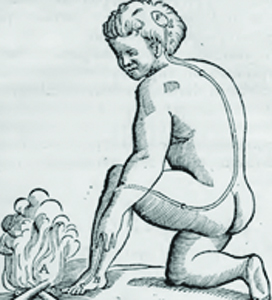By Dershnee Devan
Rene Descartes was one of the first philosophers to describe the somatosensory pathway of pain with the above portrayal of a boy with his foot in the fire where the peripheral input (fire) results in pain (Moayedi & Davis, 2013). However, it is far more complex this.
The perception of pain begins with stimulation of nerves with high firing thresholds (nociceptors) which do not activate until the stimulus intensity is high enough. In addition, not all transmission of stimuli will progress beyond the level of the spinal cord due to an effective gate keeping system in the dorsal horn of the spinal cord known as the Spinal Gate (Melzack, 1999). This system allows transmission when the intensity of input is sufficient and when there is a barrage of nociceptive input from the periphery.
Yet getting through the “gate” is not a guarantee that you will feel pain. The brain receives the input from the periphery via the spinal cord and spends some time analysing this information. And that’s where it gets interesting.
The context of the nociception – where you are, who is with you and prior pain experience and pain memories in this context all start to play a role. This influences the brain’s evaluation of how important and threatening this unpleasant sensation really is. Once the brain decides based on experience, context, stimulus intensity and threat value that this input is indeed important and dangerous it will produce pain. That pain will direct your subsequent behaviour to move away from the stimulus, seek medical attention or treat it with whatever you may deem to be appropriate.
This revised portrayal below of the Rene Descartes boy with his foot in the fire illustrates the context to an extent.
Where do we feel pain?
We feel it in our brain; it is the only organ capable of producing pain. Even though we can locate the site of the pain i.e. a place on our body (leg, arm etc.) it is produced by the brain thus we really feel pain in our brain!!!
I appreciate that this may be a hard concept to take on and understand if you are not familiar with the pain science, yet it is inexplicably true. As one learns more about pain you realise it really is not as simple as it seems.
References
Melzack, R. (1999). From the gate to the neuromatrix. Pain, 82 (1 Suppl), S121-S126. doi: 10.1016/s0304-3959(99)00145-1
Moayedi, M., & Davis, K. D. (2013). Theories of pain: from specificity to gate control. J Neurophysiol, 109(1), 5-12. doi:10.1152/jn.00457.2012
